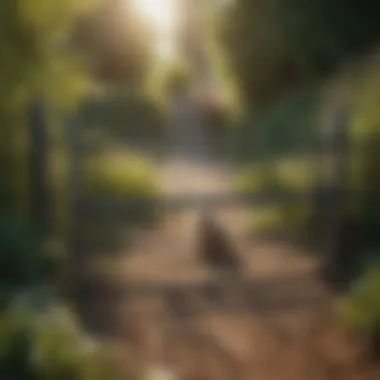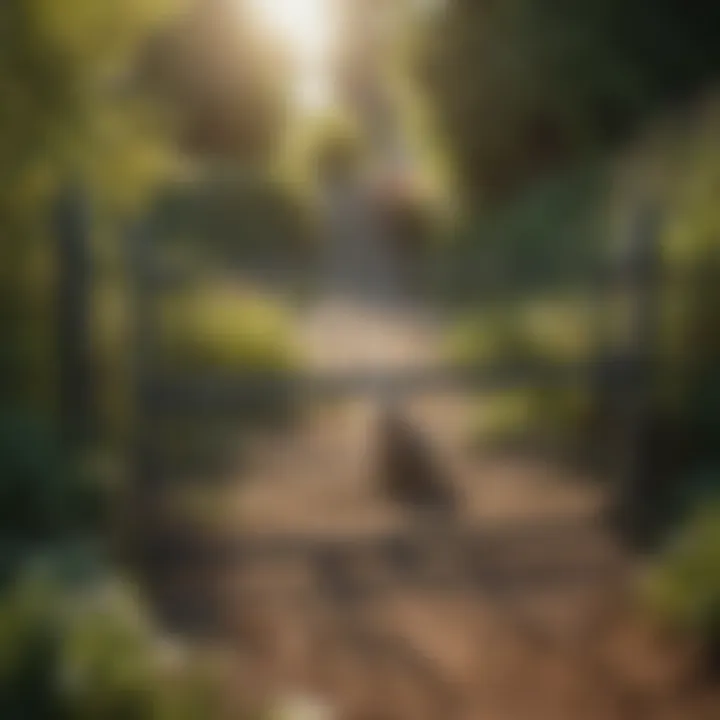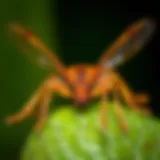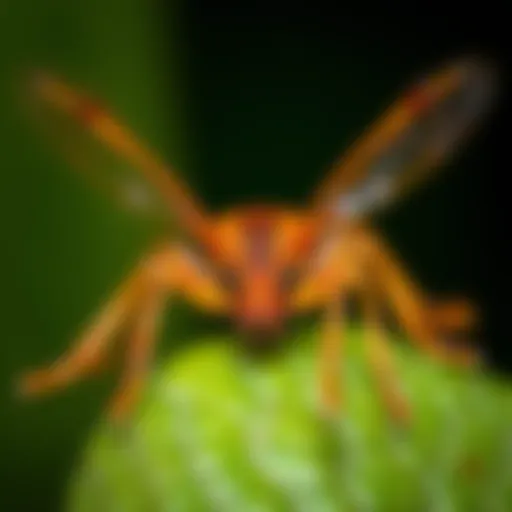Effective Strategies to Keep Groundhogs Out of Your Garden


Intro
Groundhogs, or as some folks call them, woodchucks, can turn a thriving garden into a barren wasteland in no time flat. These furry creatures, while cute, are notorious for their insatiable appetites for veggies and flowers. Any gardener knows that finding a solution to curb their mischief is as essential as watering the plants.
In this article, we will embark on a journey to understand these pests a little better. We’ll discuss how to identify the telltale signs of groundhog activity, explore practical and effective prevention strategies, and look into various treatment options. By the end, you’ll have the tools you need to protect your garden while maintaining the balance of nature that makes your outdoor space a joy.
Pest Identification
Knowing your enemy is half the battle. Groundhogs are a common sight in many gardens, particularly in suburban areas. The first step to keeping them at bay is understanding what they are and how to spot their presence in your garden.
Detailed Descriptions of Common Pests
Groundhogs belong to the rodent family and can weigh up to 14 pounds. Their bodies are stout, with a bushy tail and short legs. They have a range that stretches from the eastern United States to parts of Canada. If you see a creature with a grizzled brown coat and large front teeth, you’ve likely spotted a groundhog.
Signs and Symptoms of Infestations
Groundhogs leave behind clues that can help you identify their presence in your garden. Here are some things to look out for:
- Burrows: These animals love to dig, creating extensive networks of tunnels. Look for holes around the perimeter of your garden.
- Chewed Plants: If you find nibbled flowers and vegetable leaves, check for groundhog activity.
- Droppings: Similar to those of a small cat, these can often be found near their burrows.
"The best way to protect your garden is to understand how groundhogs operate. Knowledge is your first line of defense."
Prevention Strategies
Once you identify groundhog activity, it’s crucial to implement prevention strategies to protect your garden. Here’s a look at a few effective methods to keep these critters at bay.
Home Maintenance Tips for Pest Prevention
Keeping your garden clean and free from food sources is essential. Here are several tips:
- Seal Entrances: Thoroughly inspect your home’s foundation and outside areas for gaps or holes. Seal any openings to deter burrowing.
- Trim Overgrown Plants: High grass and dense shrubbery can provide shelter for groundhogs. Regularly cut back these areas.
- Store Garden Tools Properly: Leaving tools around can create hiding places, so keep them organized and stored away safely.
Natural Deterrents and Barriers
There are several natural remedies and physical barriers that can be surprisingly effective:
- Fences: A fence installed around your garden, at least 3 feet high and buried 1 foot deep, can deter groundhogs.
- Predator Urine: Using urine from natural predators, like foxes, can make groundhogs think twice about entering your garden.
- Plants Deterrents: Some plants, like mint or garlic, have scents that groundhogs dislike, which can act as a natural repellent.
Treatment Options
If your efforts to prevent groundhogs fail, it might be time to consider treatment options.
Overview of Chemical vs. Natural Treatments
When it comes to controlling groundhog populations, you may look at both chemical and natural treatments. While chemicals might offer a quick fix, they can disrupt the ecosystem. Natural methods are generally considered safer, especially in gardens closer to food sources.
Step-by-step Guides for DIY Treatments
- Creating a Homemade Repellent: Mix chili powder, garlic, and water to create a spray that can deter groundhogs from your garden.
- Setting Up Traps: If necessary, humane traps can be placed near burrowing sites to capture groundhogs without harming them. Just be sure to check local regulations regarding the relocation of wildlife.
- Ultrasonic Repellers: These devices emit high-frequency sounds that are irritating to groundhogs but inaudible to humans.
By actively engaging with these strategies, not only can you protect your cherished plants, but you can do so in a way that's considerate of the natural environment. Gardening should be an enjoyable, flourishing endeavor—keeping groundhogs at arm's length is just one part of the process.
Understanding Groundhogs
When it comes to safeguarding your flower beds and veggie patches, a solid grasp of the culprits—groundhogs—is your first line of defense. Understanding these creatures is crucial for garden enthusiasts looking to ward off damage effectively. Groundhogs, often deemed pests, have a fascinating biology and behavior that, once understood, can empower you to implement the most effective strategies to keep them at bay.
Biology and Behavior
Groundhogs, also known by the charming nickname "whistle pigs," are a species of rodent belonging to the sciuridae family. These hefty creatures can weigh anywhere from five to fourteen pounds, with stocky bodies and short legs. Their fur is generally a mix of gray and brown, providing a natural camouflage in their typical habitats.
When it comes to behavior, groundhogs are primarily diurnal, meaning they are most active during daylight, particularly in the early morning and late afternoon. This trait plays an important role in planning effective management strategies. They are known for their burrowing skills, creating elaborate tunnel systems that can extend as much as 30 feet underground. These burrows serve not only as homes but also as protection from predators.
Furthermore, groundhogs are territorial. Males especially will fiercely defend their turf during the mating season, which peaks during late February to early March. Understanding this territorial behavior can be key when devising strategies that set up boundaries around your garden.
Common Habitats
Groundhogs are flexible in their choice of habitats, often found in areas that offer a balance of food sources and shelter. They prefer areas with low shrubs and herbaceous plants, as these locations provide both cover and sustenance. Typically, you can find them in:
- Suburban areas: Gardens and lawns provide ample opportunities for foraging.
- Grasslands: Open spaces offer both food and ease of movement.
- Forested areas: These serve as sites for burrowing and shelter.
By recognizing these common habitats, homeowners can strategize on how to limit groundhog access to their personal gardens effectively.
Feeding Habits
What truly draws groundhogs to your garden are their eating habits. These critters are herbivores, favoring a diet rich in vegetation, which includes:
- Vegetables: Groundhogs have a particular liking for beans, lettuce, carrots, and tomatoes.
- Fruits: They won't hesitate to munch on strawberries, melons, and other juicy fruits.
- Plants: Clovers, dandelions, and even some ornamental shrubs are on their menu.


By understanding what groundhogs are likely to nibble on in your garden, you can make targeted decisions about what to plant or relocate. It's merely common sense that, if you can steer clear of their favorite snacks or make them less accessible, your garden stands a better chance.
"An ounce of prevention is worth a pound of cure."
Being proactive about understanding groundhogs lays the groundwork for successful pest management in your cherished outdoor space.
Identifying Groundhog Damage
Recognizing groundhog damage is crucial for any garden enthusiast. These critters can wreak havoc if not monitored closely. Early identification can save a gardener from extensive loss. Groundhogs, known for their hearty appetites, can wreak havoc on plants, but understanding the signs of their presence can help homeowners take preventative measures promptly.
Signs of Infestation
Detecting signs of infestation can be quite straightforward if one knows what to look for. Groundhogs leave behind several telltale signs, which can include:
- Burrows: One of the most prominent indicators. Look for holes about 4-5 inches in diameter at the base of plants or structures; these are their entry points.
- Trampled Grass: If you notice areas in your garden that appear flattened or disturbed, this might indicate groundhog activity.
- Droppings: Groundhog droppings resemble small, dark pellets. Finding these around your plants may signal their presence.
- Chewed Plants: Newly nibbled leaves or stubs where plants used to be serve as clear evidence of munching.
“A stitch in time saves nine” captures the essence here; early detection can save you from significant hassles later on.
Familiarizing yourself with these signs not only arms you with knowledge but also provides the opportunity for timely action against these persistent pests.
Types of Damage to Gardens
Groundhogs can be true garden marauders, causing a variety of damage. Their feeding habits can lead to considerable loss, impacting both aesthetic and economic value. Keep an eye out for the following types of damage:
- Vegetation Destruction: Groundhogs are herbivores, enjoying leafy greens, vegetables, and even flowers. They tend to munch on the tender parts, leaving behind just the stalks.
- Root Damage: Not only do they consume the above-ground portion of your plants, they often dig and chew on roots, which can lead to the plant's eventual death.
- Disturbed Soil: Their burrowing can loosen the soil structure, which may contribute to erosion and root instability around nearby plants.
- Negative Impact on Organic Growth: Gardens centered around organic gardening principles can suffer if pests aren’t controlled, especially as groundhogs can contaminate the soil or nearby plants.
Addressing the damage these animals can cause requires vigilance and knowledge. From assessing signs of infestation to recognizing the broader implications of their actions, staying informed is your first line of defense.
Evaluation of Garden Layout
Evaluating your garden layout is not just a chore; it’s an essential strategy for keeping groundhogs at bay. These critters have a knack for finding the easiest way to a fresh meal, so understanding your garden’s setup can help in mitigating the risks. By identifying where groundhogs might choose to enter and assessing which plants might attract them, homeowners can design a resilient garden.
By mapping out your garden and identifying the various zones, you can enhance your defensive strategies. Consideration of elements like pathways, plant placements, and open areas becomes vital. Creating a labyrinth or even a simple obstacle course can thwart a groundhog's straightforward approach.
Also, maintaining a tidy garden limits the hiding spots for these animals. When the ground is cluttered with debris, it becomes an inviting place for groundhogs to settle. Keeping things orderly not only increases your garden's visual appeal but also makes it less hospitable to unwanted guests.
Assessing Vulnerable Areas
When it comes to groundhog-proofing your garden, knowing the vulnerable areas can make all the difference. Look out for:
- Perimeter Zones: Assess the edges of your property where groundhogs might enter.
- Garden Entrances: Are there wide spaces without barriers? Consider how easy it is for these pests to waltz into your sanctuary.
- Plant Types: Certain plants can attract groundhogs more than others. If you have beloved vegetables like lettuces or tender seedlings, they’re grounds for an easy buffet.
By marking these spots, you can prioritize your barriers and defenses effectively. Remember to check these areas regularly. A groundhog can dig faster than you might think, and catching them early can save you a lot of hassle later.
Strategic Planting
Planting with intention is another proactive step. While it’s tempting to plant your favorites wherever there is space, this could spell trouble when groundhogs are involved. Here’s where strategic planting comes into play:
- Using Deterent Plants: Some plants are not appealing to groundhogs, such as lavender, marigold, or garlic. By integrating these plants throughout your garden, you can create a natural repellent.
- Grouping Vulnerable Plants: Keeping plants that are prime targets for groundhogs grouped together can help you focus your protective measures such as fencing or other barriers without overwhelming your whole garden.
- Heightened Visibility: Consider how you plant your taller crops. Dense, low-growing plants can provide cover for groundhogs while they approach. Positioning taller plants on the outer rings can help cut down on hiding spots.
Thinking deliberately about where to position your plants not only cultivates a flourishing garden but also keeps those pesky groundhogs at arm’s length.
Effective garden layout planning can deter groundhogs and protect your flora, ensuring lush growth in a secure environment.
Physical Barriers for Protection
Establishing physical barriers is a fundamental step in safeguarding your garden from groundhog invasions. These creatures are notorious diggers and can swiftly undermine efforts to cultivate flowers or crops. Therefore, erecting formidable defenses aids in protecting your hard work and investment.
In this section, we’ll explore various physical barriers that help deter groundhogs effectively. Implementing these strategies not only promotes a successful gardening experience but also minimizes the frustration that comes from battling persistent pests.
Fencing Options
A sturdy fence can serve as the first line of defense against pesky groundhogs. However, not all fences are created equal. Using materials like woven wire or chain link that extend at least a foot below ground level is crucial, as groundhogs are skilled diggers.
Consider these points when selecting your fencing:
- Height: A fence should ideally be at least three to four feet tall to discourage jumping.
- Angle: Install an outward-facing angle at the top of the fence to thwart climbing attempts.
- Digging Prevention: Bury a section of the fence underground, about 12–24 inches, to prevent burrowing from below.
Investing time and resources into an effective fencing system may seem daunting. Still, it pays dividends in protecting your beloved plants against nocturnal nibblers.
Netting and Covers
When additional protection is needed, netting and covers can be incredibly effective in keeping groundhogs at bay. These materials create a physical barrier preventing access to vulnerable plants. Here’s how they work:
- Netting: Lightweight and versatile, garden netting can be draped over plants or entire beds. Its fine mesh keeps groundhogs away while allowing sunlight and rain to nurture the plants beneath.
- Covers: Use solid covers, like row covers, that shield plants from direct encounters with groundhogs. Choose materials that allow ventilation, so plants don't suffocate under the cover.
Remember to secure these covers well. Groundhogs are clever and persistent, so any loose ends may give them the opportunity to sneak in.
Trenches and Deep Barriers


In extreme cases, consider implementing trenches or deeper barriers as a proactive defense strategy. This method requires more extensive groundwork but will significantly impede any groundhog's ambitions to invade your garden.
- Digging a trench: Create a trench that is at least two feet deep and the same width. Line the bottom and sides with a solid material like concrete or thick plastic, deterring digs from either side.
- Deep barriers: Installing additional barriers below the surface, like heavy timbers or metal sheeting, can act as a deterrent too. If groundhogs realize they cannot burrow through, they will likely abandon the effort altogether.
"By combining multiple physical barriers tailored to your garden's layout, you create a fortress that groundhogs will find hard to penetrate."
Natural Deterrent Techniques
The natural deterrent techniques are vital components when it comes to protecting gardens from groundhogs. These methods harness the power of nature itself, creating an environment that discourages these burrowing critters without resorting to harmful chemicals or traps. Engaging in these practices not only makes your garden less appealing to groundhogs but also promotes ecological balance in your backyard.
Using Companion Plants
Companion planting involves growing certain plants together to enhance each other's growth while naturally repelling pests. In the context of groundhogs, some plants are particularly effective in warding them off. Strongly scented herbs like rosemary, sage, and lavender emerge as excellent companions. Their aromas are not only delightful for humans but can be off-putting to groundhogs.
When selecting companion plants, choose a variety of herbs and flowers known for their pungent scent. By strategically planting these around the perimeter of your garden or interspersing them throughout, you can create an unwelcoming atmosphere for groundhogs. Additionally, plants such as marigolds are reported to deter various pests, including groundhogs. This method can help in maintaining the health of your garden while benefiting the pollination of your flowering plants.
"Companion planting is not just a protective measure; it fosters a thriving ecosystem where plants mutually benefit from each other's presence."
In practice, assess your garden's layout and determine where to introduce these companion plants. Positioning them in vulnerable areas can create a more robust defense against groundhog invasions while enhancing the beauty of your outdoor space.
Scent-Based Repellents
Scent-based repellents serve as another natural line of defense against groundhogs. Utilizing strong odors is like sending a clear message that certain areas are best avoided. Some common household items can be transformed into effective repellents. For instance, castor oil, cayenne pepper, and vinegar can be combined in spray solutions. These scents tend to be unbearable for groundhogs, making them think twice before approaching.
To create a simple repellent spray, mix one tablespoon of castor oil and one tablespoon of cayenne pepper with two cups of water. Shake well before applying it generously around your garden and any suspected entry points. Alternatively, human hair or used cat litter scattered around can deter groundhogs due to their aversion to unfamiliar scents.
While implementing scent-based repellents, it’s worthwhile to consider rain and other weather factors that may wash away these deterrents. Consequently, it is essential to reapply them after heavy rains or every couple of weeks for optimal results.
In summary, employing natural deterrent techniques such as companion plants and scent-based repellents can significantly reduce groundhog activity in your garden. These eco-friendly methods promote a healthier environment while safeguarding your precious plants.
Electronic Solutions for Groundhog Control
When it comes to keeping groundhogs at bay, electronic solutions offer a modern touch to garden protection strategies. These methods tap into technology to deter unwanted visitors without resorting to chemical repellents or traps, making them a safer choice for those who wish to maintain a harmonious environment. In this section, we'll explore two prominent electronic approaches: ultrasonic repellers and motion-activated sprinklers.
Ultrasonic Repellers
Ultrasonic repellers work by emitting high-frequency sounds that are typically inaudible to humans but can be quite irritating for groundhogs and other pests. The beauty of these devices lies in their ability to cover a wide area while remaining discreet in a garden setting. They can be placed strategically at key points around the perimeter, acting as an invisible yet effective barrier against inquisitive groundhogs.
Benefits of Ultrasonic Repellers:
- Non-Invasive: Unlike traps, these devices do not kill or harm animals, aligning with humane treatment principles.
- Easy Installation: Simple plug-and-play models mean you can set them up in no time.
- Stealthy Operation: Their discreet nature means they won't disrupt the visual appeal of your garden.
Considerations include the potential variability in effectiveness, as some animals may become accustomed to the sounds over time. It's wise to use these devices in conjunction with other deterrents for optimal results. Ensure you choose a model with multiple frequency options, as this helps to prevent any habituation among the groundhogs.
Motion-Activated Sprinklers
These clever devices not only keep your plants hydrated but also provide an unexpected spa treatment for pests. Motion-activated sprinklers are triggered by movement, releasing a sudden burst of water that startles any nearby groundhog, sending it running for the hills. The element of surprise tends to yield great results, particularly for small critters who frequently visit gardens.
Benefits of Motion-Activated Sprinklers:
- Dual Functionality: They help with irrigation while functioning as a deterrent.
- Immediate Response: The reaction time of these devices is usually swift, making it difficult for any groundhog to linger too long.
- Adjustable Settings: Many models allow you to tweak the sensitivity and the spray distance, catering to various garden sizes.
Similar to ultrasonic repellers, there are some factors to consider. For example, if your garden receives heavy rainfall, make sure the sprinkler isn’t activated unnecessarily, soaking the area when it’s already damp. Additionally, the system should be placed carefully to avoid spraying unsuspecting humans or pets!
"Electronic deterrents can be a game-changer in the quest to protect gardens from groundhogs, proving that sometimes, a little tech can go a long way."
Humane Trapping Methods
When it comes to managing groundhog populations in a responsible manner, humane trapping is often seen as a viable strategy. This method allows for the safe relocation of the animal rather than extermination, appealing to those who prefer a non-lethal approach to pest control. It’s crucial to understand that, while this might seem like a straightforward solution, effective humane trapping requires careful thought, planning, and awareness of legal regulations.
One of the primary benefits of humane trapping is its compassion; it caters to those gardeners who appreciate wildlife and want to avoid harm to the environment. Moreover, correctly implemented trapping methods can help in reducing the damage caused by groundhogs while ensuring that the animals are not killed or harmed in the process. Not to mention, it sets an example for responsible gardening practices.
Choosing the Right Trap
Selecting an appropriate trap is paramount to successful humane trapping. Not all traps are created equal, and there are several factors to consider:
- Size Matters: It’s essential to choose a trap that is designed specifically for groundhogs. A trap that’s too small may injure the animal, while one that’s too large might not lure the animal effectively.
- Material Quality: Look for sturdy materials, as groundhogs are quite powerful. Traps made from thick gauge wire are advisable.
- Design Consideration: Tunnel traps can often be more effective than open traps, as they mimic the natural burrowing behaviors of groundhogs, making them more likely to enter.
- Baiting and Placement: A well-placed trap with the right bait can enhance the chances of catching the groundhog. Popular baits include fresh vegetables or fruits that have a scent – think apples or carrots.
In short, the right trap can make all the difference, so don’t rush this part. Take the time to consider your options before making a purchase.
Best Practices for Trapping
Once you've secured a well-suited trap, it's best to adhere to certain practices that will improve your chances of success:
- Choose a Strategic Location: Position the trap near burrows or areas where you have spotted groundhog activity. This might mean observing your garden closely for signs of use.
- Be Patient: Groundhogs may not enter the trap immediately. Persistence is key; leave the trap in place for a few days to gauge activity.
- Check Traps Regularly: It’s vital to check traps at least once a day. This minimizes stress on the trapped animal and allows for timely relocation.
- Avoid Disturbance: When setting the trap, minimize disturbance in the area. Groundhogs are skittish creatures, and a sudden change in their environment can scare them away.
- Practice Humane Relocation: Be sure to release the groundhog in a suitable environment away from human habitation. Establishments often have rules about specific distances to minimize returning issues.
By using humane trapping methods, gardeners can protect their beloved plants without compromising their principles or the well-being of the animals.


It’s essential to remember that humane trapping isn’t just about catching the critters; it’s a way to coexist with the wildlife around us while still maintaining control over our gardens. By implementing proper strategies and thorough research, homeowners can ensure that both their gardens and the local ecosystem are respected.
Long-Term Prevention Strategies
In the realm of gardening, long-term prevention strategies become essential when dealing with groundhogs. These clever critters can swing into your garden like a hundred-dollar bill in a casino, causing havoc if you're not prepared. By focusing on sustainable, preventive measures, homeowners can effectively create a fortress around their green spaces, ensuring that the soil remains intact and the plants flourish without the threat of unwelcome nibblers.
Implementing a strategy isn’t just about the occasional barrier, it’s a continuous process. For one, it fosters a proactive mindset when it comes to pest control. You ain't waiting for the damage to happen; instead, you set the stage to keep groundhogs at bay right from the get-go. This proactive approach can save both time and money in the long run and keeps your garden lively and beautiful.
Benefits of Long-Term Prevention
A few advantages of embracing these strategies include:
- Cost-Effectiveness: Over time, investing in barriers and deterrents can be far less expensive than continual damage control approaches.
- Greater Yield: A healthy garden translates to a bountiful harvest. Restrictions on pest access mean more produce for your kitchen.
- Peace of Mind: Knowing your garden is safe allows you to enjoy your outdoor space more thoroughly, without constantly peering over your shoulder for nuisance wildlife.
Aspects such as habitat management and community awareness should also come into play. Taking the time to make small changes to your garden’s layout, or being vocal in your community about the importance of preventing groundhog intrusions can make a world of difference.
Maintaining Vigilance
Vigilance plays a significant role in keeping groundhogs out of your garden. It's about being the watchful eye that never blinks. Regular check-ups around your garden can be the difference between a thriving vegetable patch and a snack bar for local wildlife.
Here are a few practical ways to maintain a vigilant approach:
- Regular Inspections: Walk through your garden often, noting any unusual behavior or signs of groundhog presence, such as burrows or scratch marks.
- Document Changes: Keep a diary of what you spot. If you see a hole one week, check if it enlarges or if fresh diggings occur. Consistency can show patterns that tell you when action is needed.
- Immediate Action: When you identify signs of groundhog activity, act fast to implement any necessary defenses. Don’t wait until they’ve eaten half your tomatoes!
Often, the best defense is a good offense in the form of early intervention. Adjustments to barriers, even on a whim, can keep the critters guessing.
Community Awareness
Groundhog control isn’t solely an individual responsibility; it's a community effort. When one neighbor finds success, it can spark a wave of motivation and change throughout the neighborhood. Creating awareness and sharing strategies with neighbors can amplify the effects of whatever method you choose.
To foster a community atmosphere around the issue, consider:
- Organizing Community Workshops: Host gatherings that educate on gardening practices that deter groundhogs. Share techniques, tools, and experiences.
- Building a Support Network: Create groups or online forums, perhaps a Facebook group, where locals can share updates or tips about the pesky groundhogs and ways to rid them. Reddit could also provide valuable crowd-sourced advice from folks already vanquishing these challengers.
- Collaborative Action: Plan joint efforts to landscape or set up barrier systems that ward off groundhogs, benefiting all gardens involved.
"An ounce of prevention is worth a pound of cure.”
This age-old wisdom rings especially true in the context of gardening. Community pooling of knowledge and resources ensures that you’re not just defending your own garden but creating a buffer with collective power against groundhogs.
Evaluating Effectiveness of Methods
When it comes to protecting your garden from pesky groundhogs, taking the time to evaluate the effectiveness of your chosen methods is critical. This phase not only helps ascertain what strategies are working but also allows for timely adjustments. Without this step, homeowners may waste resources on ineffective measures or, worse, find their beloved veggies decimated once again.
Proper evaluation acts as a feedback loop, ensuring that actions taken yield the desired results. Here are some considerations to keep in mind:
- Assess whether you've seen a decrease in groundhog activity or damage since implementing your strategies.
- Determine if certain plants appear to be thriving or are still being nibbled despite protective measures.
- Gauge the emotional satisfaction of maintaining your garden free from unwanted visitors.
By measuring these facets, homeowners can feel empowered in their pest management efforts.
Monitoring Groundhog Activity
Keeping an eye on groundhog activity is not just for the birds; it’s essential for garden preservation. Regularly observing the areas around your garden will help you catch signs before they turn into larger problems. Here’s how to do it effectively:
- Check freshly dug holes or signs of burrowing near your garden border. Groundhogs love to dig, so spotting fresh dirt can signal that they are lurking.
- Look for tracks, especially in the early morning or late evening when groundhogs are most active. Small, round footprint impressions can indicate a population at work.
- Install motion-activated cameras to capture footage. While it sounds like something out of a spy movie, observing groundhogs remotely provides you with valuable insights about their habits.
By staying vigilant and understanding their patterns, you can devise more effective responses.
Adapting Strategies Accordingly
As any seasoned gardener knows, the path to a flourishing garden is rarely a straight line. To deal with evolving groundhog habits, it's wise to be versatile in your approach. Here’s how you can adapt your strategies:
- Analyze data from your monitoring efforts. If you notice that certain deterrents are less effective, don’t hesitate to switch it up. Maybe you'd find ultrasonic repellers are fading in effectiveness – that’s your cue.
- Rotate plantings within your garden. Groundhogs can become accustomed to the same plants over time. Experimenting with new varieties can shake things up.
- Engage with local communities; places like forums on Reddit or Facebook groups provide a treasure trove of tips based on collective experiences. You might discover tactics others have found particularly effective.
Adapting requires a bit of patience and observation, but the end reward for your efforts can be a vibrant, groundhog-free garden that offers both satisfaction and productivity.
"In the world of gardening, adaptability is often the key to success. Those who can change their game will foster a better chance of thriving."
By dotting I's and crossing T's in these evaluation methods, you ensure a more productive and enjoyable gardening experience.
Culmination and Recommendations
In wrapping up this discussion on keeping groundhogs at bay, it’s crucial to acknowledge the intricate balance between nature and our gardening ambitions. Groundhogs, while charming in their own right, can be formidable foes to the home gardener. This article has offered numerous effective strategies tailored to meet the needs of homeowners looking to protect their beloved gardens. By implementing a combination of physical barriers, natural deterrents, and long-term preventative measures, homeowners can cultivate a garden space that's both lush and resilient against these burrowing pests.
Summary of Key Points
To synthesize the points covered:
- Understanding Groundhogs: Knowing their behavior and habits is fundamental to develop effective control strategies.
- Damage Assessment: Identifying signs of groundhog activity helps in recognizing the extent and types of damage they can cause.
- Preventive Mechanisms: Using fencing, netting, and companion planting effectively deters these creatures.
- Monitoring and Adaptation: Continuously observing groundhog behavior aids in adjusting strategies as needed.
- Sustainable Practices: Focusing on non-lethal interventions ensures the ecological balance of our outdoor spaces is maintained.
In summary, protecting your garden isn't just about waving a wand; it's about playing smart chess with nature.
Encouragement for Sustainable Practices
Taking care of our gardens shouldn’t mean throwing the environment under the bus. Embracing sustainable practices not only benefits our gardens but also nourishes the local ecology. Here are a few recommendations:
- Use Native Plants: These often require less maintenance and are more resilient to local pests.
- Encourage Natural Predators: Be it birds or certain beneficial insects, inviting natural predators helps keep away groundhogs and other pests without human intervention.
- Consider Organic Deterrents: Sprays made from essential oils can provide a pungent barrier that is harmless to other wildlife.
- Community Initiatives: Engage with local gardening groups to exchange tips and share experiences. Often, collective knowledge provides the best insight into effective methods suited to your region.
Ultimately, cultivating an awareness of both our gardens and the creatures that inhabit them can turn mere survival into flourishing ecosystems. Let’s nurture our spaces without resorting to extremes; as stewards of the land, it’s our duty and privilege.



